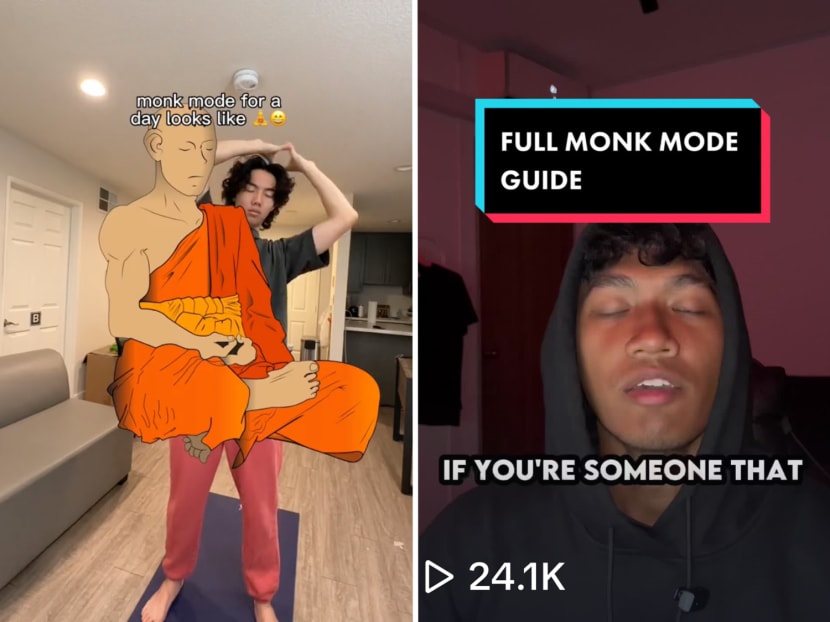#trending: What is 'monk mode'? The anti-distraction trend promises a productivity boost, but not all agree
Consuming five different forms of media at once to prevent the chance of a thought occurring? If this feels familiar, TikTok says it's time to take a step back.
"Monk mode", one of the latest buzzwords on the short-form video platform, promotes an approach to productivity inspired by the age-old monastic traditions of eliminating distractions in order to practise focus and discipline.

TikTok's latest approach to productivity, "monk mode", takes inspiration from age-old monastic traditions of eliminating distractions in order to practise focus and discipline.
- "Monk mode", TikTok's latest productivity trend, promotes a single-tasking approach
- It is inspired by the age-old monastic traditions of eliminating distractions
- The practice appears to be especially popular among entrepreneurial circles
- However, some argue that monk mode can be superficial, challenging and exclusionary
SINGAPORE — Consuming five different forms of media at once to prevent the chance of a thought occurring? If this feels familiar, TikTok says it's time to take a step back.
"Monk mode", one of the latest buzzwords on the short-form video platform, promotes a single-tasking approach to productivity inspired by the age-old monastic traditions of eliminating distractions in order to practise focus and discipline.
Though the term appears to have been around since the late 2000s and first went viral on TikTok last year, it has recently seen a resurgence on social media, with 69.3 million views related to the hashtag on TikTok — up from 31 million in May, the BBC reported last Monday (Oct 2).
WHAT IS MONK MODE?
Monk mode appears to be especially popular in entrepreneurial circles, with founders and chief executive officers (CEOs) supposedly swearing by it and the rise of motivational TikTok accounts centred on it.
But how does one put it into practice? In a TikTok video posted last September, which has since gained 1.5 million views, self-proclaimed entrepreneur Nick Gaines says: "Monk mode is just a period of time with the main intention of starving distraction in order to feed focus."
The actual process seems to vary from person to person, but distractions commonly include social media, technological devices, alcohol and caffeine.
For Russian entrepreneur-influencer Iman Gadzhi, 23, monk mode includes the following "non-negotiables": 10 minutes of daily meditation, 30 minutes of daily exercise and no alcohol or drugs. He also avoids meeting people apart from his girlfriend or mother.
"It's not specified, but when I'm in monk mode... my friends know," said Mr Gadzhi in a TikTok video posted last August. "And it's like: 'Okay, I'm not seeing him for this period of time.'"
According to allergy care provider Wyndly founder and CEO Aakash Shan, the general idea is "giving yourself the permission to ignore everything but the task you’ve chosen to single-mindedly pursue".
While Mr Gadzhi estimates a period of about two months for his monk modes, there is no set length of time one has to dedicate to it.
Singaporean trader Brad Goh, known on YouTube as "The Trading Geek", said in a TikTok video posted in July that he "likes to go on monk mode for about three to six months".
Mr Gaines, on the other hand, started off with a "21-day monk mode protocol" inspired by Mr Gadzhi's apparent success. Two days in, he shared in an update that he was "already starting to see the benefits".
Likewise, Mr Goh claims that monk mode "changed (his) life". A typical day in monk mode for him would involve waking up at 6am, hitting the gym and studying trading in the morning.
He would then practise his trades in the afternoon and record them in his trading journal at night.
"So I would literally do this for every single day, day in, day out," he said in his TikTok video. "Literally military discipline, military routine, for three to six months. That is how I became successful."
““Monk mode is giving yourself the permission to ignore everything but the task you’ve chosen to single-mindedly pursue.”– Aakash Shah, founder and CEO of allergy care provider Wyndly”
CRITICISED AS EXCLUSIVE
However, a common gripe among viewers is that monk mode enthusiasts often put out "superficial" motivational videos declaring that the practice made them successful, but without much clarity on what they actually do during that period.
Common questions on Mr Gadzhi's TikTok videos include: "What do you specifically do while in monk mode?" and "what benefits do you notice from doing this process?"
On Mr Gaines' video explaining "how Iman Gadzhi made US$25 million (S$34.2 million)", the top comment reads sarcastically: "Ya bro it's monk mode that got him 25 mil".
Monk mode has also been criticised as "exclusionary", as not everyone has the capacity and resources required to commit to it.
"Not everyone has the privilege to go into 'monk mode'," wrote Jade Biggs of Cosmopolitan UK in February. "At what point during the day does a single mother have time to meditate?
"How do those with mental health conditions safely isolate themselves from their loved ones? The list goes on, and on."
Similarly, TikTok user "unfilteredfemininity" confessed in a video posted last month on the second day of her monk mode journey that "it's just a lot, for real".
"It's a lot of things that I know I have to get done, like my non-negotiables, every single day," she said. "Whether it's exercising, meditating, reading... It's just so many things that I need to make sure that I'm doing every single day."
Stemming from the realm of entrepreneurship, it is also strongly associated with "hustle culture" and financial success.
In in a TikTok video from last December, American entrepreneur influencer Arlin Moore said his problem with monk mode is that the social isolation of the trend could inadvertently drive men towards a "very red-pill path of borderline misogyny".
Indeed, proponents of monk mode appear to be predominantly male. Reddit users have also claimed that the practice has its roots in "manosphere red-pill" thought, referring to a broad collection of websites and online communities which promote masculinity, misogyny and opposition to feminism.
Mr Moore also argues that rather than helping with productivity, monk mode could instead lead to faster burnout "because you don't have any (social time to rejuvenate)".
RELAXING THE RULES
However, it appears that some are taking it upon themselves to rebrand monk mode as a more relaxed approach rather than a full-on extended period of strict discipline and abstinence.
In a YouTube guide to monk mode, posted in July, a Singaporean business owner who goes by the name Khai stressed: "Your three non-negotiables can be very, very simple as well. For me, when I first started out, my non-negotiables were to go for a walk every single day. How simple is that?
"That’s the beauty of it," said Mr Khai, who owns lifestyle clothing brand Okami. "It should be so personalised for you, and it should be so easy to get the ball rolling."
Mr Shah puts a more casual spin on the trend in what he calls "monk mode mornings" — during which he recommends that you block out your calendar, use noise-cancelling headphones or white noise and commit to not checking notifications, among other tips.
American university student Riley Yen posted a TikTok video of himself "trying out monk mode for a day" in January, citing "the core structure of three 'I's": Introspection, isolation and improvement.
In between bouts of work, he practises meditation and qigong and even takes a trip to Starbucks when he's feeling restless.
As far as the United Kingdom, the United States and the Middle East, people are also turning to distraction blocker apps such as Freedom, Cold Turkey, FocusMe and Forest to cut off their own access to specific social media platforms or websites.
London-based human rights lawyer and author Susie Alegre told BBC that she uses the Freedom app instead of turning off her smartphone "when (she) needs to be contactable on the phone, but (she) really doesn't want to be distracted".
This might be especially helpful for children and youths today, whose childhoods could be defined by close to a decade of social media use.
Singaporean teenagers and youths interviewed by TODAY in July spoke of how social media addiction has negatively affected their lives and emotions, though most have not stopped using it completely.
Vladimir Druts, co-founder of FocusMe, sees social media addiction as a serious issue that is often overlooked by society. Monk mode, then, simply allows one the time and headspace to get work done.
"A lot of the stuff in the zeitgeist today is 'hey get rich quick, make your millions in an instant'," he told BBC. "Monk mode is a necessary contrast to say 'you're not going to accomplish anything unless you carve out the time every single day and just show up'."
With the rise of artificial intelligence, Mr Druts believes that the amount of distractions from technology are only going to increase.
"Monk mode is definitely going to be gaining steam."











